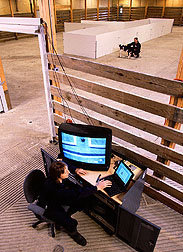Livestock Behavior Facility Opens
New laboratory aids study of animals' response to environment and stresses.
It's a high-tech laboratory for scientific research, though it looks like an ordinary livestock building. The newest research facility for the ARS Livestock Behavior Research Unit is built for cattle and hogs—and the scientists who study them.
"It's a real laboratory, not just a building," says Julie Morrow-Tesch, an animal physiologist/ethologist who heads the unit. But the 10,000-square-foot structure built in 1996 and opened in early 1997 was designed for scientific research on a practical level.
"Our program has three specific objectives," says Morrow-Tesch. "These are to identify how animals perceive and interact with their environment, determine if sensory cues in their environments change animals' behavior and response to stress, and identify their preferences for environments or items in their environment that may affect their behavior and response to stress."
The size and flexibility of the new building were dictated in large part by the type of research that was to be conducted in it.
"We wanted a building large enough to conduct a wide range of studies. Now, we can quickly create any size pen or housing system inside it," she says.
One important tool the building will house is a Heb-Williams maze. This is actually a series of 12 mazes—each more difficult than the previous one—made up of gates, alleyways, and other barriers.
"Livestock spend a majority of their time looking for food, which requires spatial orientation," says Morrow-Tesch. "The maze allows us to identify and quantify their learning cues to determine what is important to them in their environments."
Historically, livestock researchers have worked in production pens and facilities. Those settings presented challenges for scientists who wanted to isolate individual animals or conduct laboratory-quality experiments. But the sheer size and weight of cattle and hogs made it impractical and often costly to design and build custom experimental pens.
The new building will enable researchers to conduct experiments in a highly controlled environment that is comfortable for both the animals and themselves. And the installation of post holes in the floor every 8 feet in all directions lets scientists build custom-sized pens and mazes using standard, commercially available livestock panels.
This will save money in the future, says Morrow-Tesch, because the scientists won't have to special-order materials or contract out for custom-size panels to complete their work. "We are committed to getting the most for the taxpayer's dollar with this project."
|
Sidebar: |
Designed to be slip-proof, the floor has narrow, ¾ -inch-deep grooves every 1¾ inches, so cattle and hogs won't lose their footing. "This was based on scientific research and to accommodate dairy cattle, which have a larger, cloven hoof and need a slip-proof surface to keep their balance," says Morrow-Tesch.
The laboratory also features a traditional physiology laboratory where scientists can prepare samples, such as blood plasma, without having to transport them off site. A built-in electronics shop allows researchers to build and maintain their own equipment.
"We do a lot of things that require us to assemble equipment for experiments. We can save money by doing this ourselves, rather than contracting out for special projects," says Morrow-Tesch.
"Our work is not in the traditional line of animal science research," she says. "Livestock behavior has never been examined in depth. Many current livestock production practices are based on tradition, or on trial and error. Our goal is to find scientific bases for behaviors and then use that information to determine what practices are best for both livestock and producers."
For example, animal physiologist Gary Weesner has discovered a chemical pathway in pigs and cloned the DNA for the chemical receptor in the pig's brain. He is currently researching the effect of the chemical on pigs' ability to cope with stress.
Scientists in the unit have also studied typical livestock behaviors, such as buller-steer syndrome. This is an aggressive behavior observed in feedlot cattle in which one individual steer is singled out and bullied by the others. It leads to illness, injury, and even death for the bullied steer and annually costs producers thousands of dollars in lost productivity.
Other research will examine the impact of common livestock management practices such as castration and tail docking, as well as feeding behavior in pigs.
"Our work with castration techniques in cattle shows no discernible difference between castrating newly weaned bulls—either by banding or surgery—and performing the procedure 3 weeks before weaning," says Morrow-Tesch. "This is important because castration affects feed intake, weight gain, and animal health." — By Dawn Lyons-Johnson,ARS.
USDA-ARS Livestock Behavior Research Unit, Purdue University, Department of Animal Science, 1026 Poultry Science Bldg., West Lafayette, IN 47907-1026; phone (765) 494-8022.







